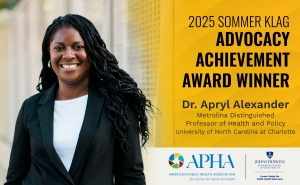Majority of U.S. States and Territories Do Not Require Day Care Providers to Inform Parents of Firearms on Premises
Only nine out of 56 states and territories require either home- or center-based child care operators to inform parents when there are firearms on-site
Home- and center-based child care providers are not required by most states or U.S. territories to inform parents when guns are stored on the premises, according to a new study from researchers at Johns Hopkins Bloomberg School of Public Health.
The researchers found that a majority of U.S. states and territories—47 out of 56—do not require either centers or homes that provide child care to disclose to clients that they keep firearms on-site. Less than two-thirds of U.S. states and territories outright prohibit center-based child care operators from having firearms on the premises and only a handful—7 of 56—outright prohibit home-based child care operators from having firearms on the premises.
The study also found that nearly one-quarter of U.S. states and territories (13) had no regulations governing firearms in child care centers, and one-sixth (9) had no regulations governing firearms in family child care homes.
The findings were published online April 22 in JAMA Network Open.
For the study, the researchers surveyed state regulations covering the presence and storage of firearms at child care facilities in the U.S., including dedicated centers as well as home-based facilities.
“It’s surprising how few states require notification to parents on whether or not a handgun is present—I think that’s a critical gap that should be filled so that parents can make a more informed decision about child care,” says study first author Sara Benjamin-Neelon, PhD, JD, the Helaine and Sid Lerner Professor in the Department of Health, Behavior and Society at the Bloomberg School.
While regulations were more likely to outright prohibit firearms in child care centers, family child care homes generally face restrictions on storage procedures only. For example, 46 U.S. states or territories require firearms present in home-based child care settings to be kept under lock and key; 29 require the ammunition to be stored separately; and 23 require the firearms to be unloaded.
There are more than 20 million children age 5 and under in the U.S., and almost two-thirds of them spend a substantial amount of time in center-based or home-based early care and education settings.
This is believed to be the first study that systematically examines firearm-related policies that apply to home- and center-based child care settings. Benjamin-Neelon and co-author Elyse Grossman PhD, JD, a policy fellow at the Bloomberg School, sought to clarify the current situation by reviewing firearm-related regulations, as of June 2019, for early care and education settings in all 50 states, Washington D.C., and the five U.S. territories. The study did not examine the consequences for noncompliance or the number of firearm-related incidents in these settings.
That lack of prohibition on guns in home-based child care settings may stem from legislators’ concerns that the Second Amendment to the U.S. Constitution protects homeowners’ rights to keep firearms, Benjamin-Neelon says. She notes that there is an ongoing legal challenge against an Illinois law banning guns from homes that serve as child care facilities.
Benjamin-Neelon and Grossman say they were most surprised by the limited notification requirements, with only 9 of the 56 jurisdictions requiring either operators of child care centers or family child care homes to notify parents when there are firearms present in the home. “States should consider regulations requiring notification to parents if there’s a firearm on the premises,” Benjamin-Neelon says.
The researchers plan to conduct further studies in this area to determine if stricter laws against firearms correlate with fewer gun-related injuries to children in home- and center-based child care settings.
“State regulations governing firearms in early care and education settings in the United States: A cross-sectional review” was written by Sara E. Benjamin-Neelon and Elyse R. Grossman.
# # #
Media contacts for the Johns Hopkins Bloomberg School of Public Health: Barbara Benham at 410-614-6029 or bbenham1@jhu.edu and Robin Scullin at 410-955-7619 or rsculli1@jhu.edu.





